


Including:
Andrea Pisano
and Taddeo Gaddi

GIOTTO’S TOWER 1334 (E3)
xxxxxAs we have seen (1307 E2), the Florentine artist Giotto di Bondone is often regarded as the founder of modern painting. He was one of the first to break away from the rigid, unemotional style typical of Gothic and Byzantine art -
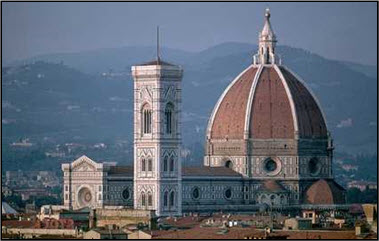 xxxxxAs we have seen (1307 E2), as a painter, the Florentine artist Giotto di Bondone is widely regarded as the founder of modern painting, breaking away as he did from the stylised, two dimensional figures so typical of Gothic and Byzantine art. He wished to portray nature rather than a symbolised form of it, and this is clearly illustrated in one of his earliest works, a large series of frescoes in the Arena Chapel in Padua illustrating the Last Judgement and, among others, the lives of Christ and the Virgin Mary. As we have seen, this series was completed in about 1307, at the beginning of the reign of Edward II, and it was around this time, too, that he began work on The Madonna in Glory, a wooden-
xxxxxAs we have seen (1307 E2), as a painter, the Florentine artist Giotto di Bondone is widely regarded as the founder of modern painting, breaking away as he did from the stylised, two dimensional figures so typical of Gothic and Byzantine art. He wished to portray nature rather than a symbolised form of it, and this is clearly illustrated in one of his earliest works, a large series of frescoes in the Arena Chapel in Padua illustrating the Last Judgement and, among others, the lives of Christ and the Virgin Mary. As we have seen, this series was completed in about 1307, at the beginning of the reign of Edward II, and it was around this time, too, that he began work on The Madonna in Glory, a wooden-
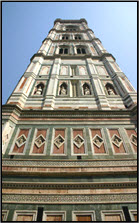 xxxxxHe appears to have come to architecture late in life. He was appointed director of public works in the city of Florence and surveyor of the Duomo there in 1334, more likely as a tribute to his work as a painter than to his skill as an architect. It was in that year that he designed the cathedral’s slim, free-
xxxxxHe appears to have come to architecture late in life. He was appointed director of public works in the city of Florence and surveyor of the Duomo there in 1334, more likely as a tribute to his work as a painter than to his skill as an architect. It was in that year that he designed the cathedral’s slim, free-
xxxxxIt was the Italian sculptor Andrea Pisano (1290-
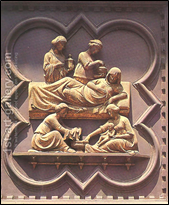
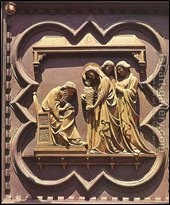 xxxxxA man who came very much under the influence of Giotto and was at one time his assistant was the Italian sculptor Andrea Pisano. After Giotto’s death he continued to carve the stone reliefs on the lower sections of the bell tower and, as chief architect, to oversee the work of construction. He is best known, however, for his skilfully executed relief panels on the bronze doors at the south entrance to the Florence Baptistry. Completed in 1336, the twenty panels depict scenes from the life of John the Baptist, together with gilded figures illustrating the eight virtues. In this work, the influence of Giotto can be clearly seen in the solid, rounded nature of the figures. (panels illustrated)
xxxxxA man who came very much under the influence of Giotto and was at one time his assistant was the Italian sculptor Andrea Pisano. After Giotto’s death he continued to carve the stone reliefs on the lower sections of the bell tower and, as chief architect, to oversee the work of construction. He is best known, however, for his skilfully executed relief panels on the bronze doors at the south entrance to the Florence Baptistry. Completed in 1336, the twenty panels depict scenes from the life of John the Baptist, together with gilded figures illustrating the eight virtues. In this work, the influence of Giotto can be clearly seen in the solid, rounded nature of the figures. (panels illustrated)
xxxxxPisano was born in Pontadera in 1290, and probably received his early training at or near Pisa, but the bulk of his work was carried out at Florence, where he came to be regarded as the founder of the school of sculpture. It would seem that he left Florence in about 1347 and spent the rest of his life at Orvieto, where he was in charge of the construction and decoration of the cathedral there. He died in 1348 or 1349.
xxxxxExquisite though Pisano’s bronze work was on the southern doors of the Florence Baptistry, we shall see that it was surpassed in the next century (1423 H6) by the Florentine artist Lorenzo Ghiberti. His workmanship on the doors of the eastern entrance marked the beginning of the golden age of bronze casting in his native city. So rare in beauty did Michelangelo consider these doors to be, that he called them The Gates of Paradise.
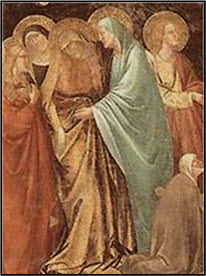 xxxxxAlso worthy of note is the Florentine artist Taddeo Gaddi (c1300-
xxxxxAlso worthy of note is the Florentine artist Taddeo Gaddi (c1300-
xxxxxDeserving of special mention is his Annunciation to the Shepherds, notable for its effective lighting, and his Tree of Life, depicting scenes from the life of St. Bonaventure, painted in the refectory at Santa Croce. In 1355, like his master, he produced a Madonna in Glory, now to be seen in the Uffizi gallery in Florence. He spent most of his life in or around his native city.
Shown below are The Annunciation, The Presentation of Mary in the Temple, and The Crucifixion.
Acknowledgements
Cathedral: date and photographer unknown. Tower: date and photographer unknown. Gaddi: Allegory of the Cross (detail) – Basilica of Santa Croce, Florence; The Annunciation – Basilica of Santa Croce, Florence; Presentation of the Virgin – Fresco, Baroncelli Chapel, Church of Santa Croce, Florence; Crucifixion – Fresco in the Sacristy, Basilica of Santa Croce, Florence.
E3-



